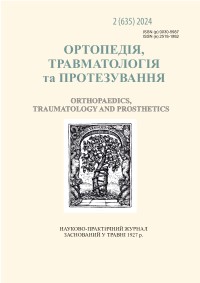A RARE CASE OF MINIMALLY INVASIVE REMOVAL OF A VERTEBRAL FOREIGN BODY AFTER A GUNSHOT FRAGMENT PENETRATING WOUND OF THE CHEST AND SPINE
DOI:
https://doi.org/10.15674/0030-59872024276-80Keywords:
Gunshot wound of the chest, gunshot wound of the spine, minimally invasive technologiesAbstract
Objective. To demonstrate the possibilities of minimally invasive technologies in the diagnosis and treatment of gunshot wounds of the chest and spine. Methods. Patient N., 42, was wounded in the chest during mortar fire. From the diagnosis: gunshot fragment blind penetrating wound chest on the right with a gunshot fracture of the right scapula, III–V ribs on the right, damage to the right lung with the presence of a metal fragment paravertebrally
on the right at the level ThV–ThVI vertebrae, right-sided hemopneumothorax, right-sided post-traumatic pulmonitis, spinal cord injury, lower paraplegia. Results. The final is established diagnosis: gunshot fragment blind penetrating wound chest on the right with a gunshot fracture of the right scapula,
III–V ribs on the right, damage to the right lung with the presence of a metal fragment paravertebrally on the right at the level ThV vertebra, right-sided hemopneumothorax. right-sided post-traumatic pneumonia, spinal cord injury, lower paraplegia. The operation was performed: video-assisted thoracoscopy on the right, revision of the pleural cavity, removal of a metal fragment from the body of the ThV vertebra, sanitation and redraining
of the right pleural cavity according to Bulau, which lasted 40 min. In the future, after 2 weeks, the stitches and signs were removed neurological deficit regressed, the wounded was sent to the military medical commission and discharged to parts. Conclusions. Gunshot wounds to the chest with spinal injury
are rare. The use of modern magnetic surgical instrument allows to remove ferromagnetic foreign bodies during vertebral injury. The use of minimally invasive operative interventions for gunshot wounds of the chest with spinal cord injury reduces operative trauma and can be applied to the third level of medical care.
References
- (2021) Atlas of Combat Surgical Trauma (Experience of AntiTerrorist Operation / Joint Forces Operation). Ed. V. I. Tsimbalyuk. Kharkiv : Collegium. [in Ukrainian]
- Boyko, V. V., Zamyatin, P. M., Beresnev, S. O., Zamyatin, D. P., Bunin, Yu. V., Provar, L. V., & Krytsak, V. V. (2020). Determination of treatment and diagnostic tactics for penetrating gunshot and stab wounds of the chest using spiral computer tomography. Kharkiv Surgical School, 4(103), 47-54. https://doi.org/10.37699/2308-7005.4.2020.09. [in Ukrainian]
- Khomenko, I. P., Hetman, V. G., Gumenyuk, K. V., Shapovalov, V. Yu., Herzhik, K. P., Safonov, V. E., Yenin, R. V., & Murodyan, K. R. (2021). Video thoracoscopic technologies for combat wounds and chest injuries. Methodological recommendations. Kyiv : Lyudmila Publishing House. [in Ukrainian]
- Zarutskyi, Y. L., Belyi, V. Ya., & Denisenko, V. M. (2018). Military field surgery: textbook. Kyiv : PHOENIX. [in Ukrainian]
- Zarutskyi, Y. L., Tkachenko, A. E., & Vovk, M. S. (2021). Clinico-epidemiological characteristics of chest wounds in servicemen during anti-terrorist operation/unmanned aerial vehicle operation. Ukrainian Journal of Military Medicine, 1(2), 87-93. https://doi.org/10.46847/ujmm.2021.1(2)-087. [in
- Ukrainian]
- Lurin, I. A., Khoroshun, E. M., & Humenyuk, K. V. (2023). Treatment of the wounded with combat injuries of the chest: monograph. ed. V. I. Tsimbalyuk. Ternopil : TNMU. [in Ukrainian].
- Lurin, I. A., Khoroshun, E. M., Negoduyko, V. V., Makarov, V. V., Bunin, Yu. V., Salyutin, R. V., & Tertyshnyi, S. V. (2022). Videothoracoscopic removal of a foreign body (arrow-shaped element) of gunshot origin from the body of a vertebra using radiation and magnetic technologies. Pediatric Surgery (Ukraine), 4(77), 84-88. https://doi.org/10.15574/PS.2022.77.84. [in Ukrainian]
- Mykhailosov, R. M., Negoduyko, V. V., Velikodny, O. M., Kovtun, K. V., Khuda, M. Yu., Shipilov, S. A., & Bunin, Y. V. (2019). Magnetic endoscopic tool for removing foreign bodies from the pleural or abdominal cavity. Patent 135918 (UA). [in Ukrainian]
- Lurin, I., Khoroshun, E., Negoduiko, V., Makarov, V., Shypilov, S., Boroday, V., Gorobeiko, M., & Dinets, A. (2023). Retrieval of ferromagnetic fragments from the lung using video-assisted thoracoscopic surgery and magnetic tool: a case report of combat patient injured in the war in Ukraine. International Journal of Emergency Medicine, 16, 51. https://doi.org/10.1186/s12245-023-00527-8.
- Miller, K., Benns, M., Bozeman, M., Franklin, G., Harbrecht, B., Nash, N., Smith, J., Smock, W., Richardson, J. (2019). Operative Management of Thoracic Gunshot
- Wounds: More Aggressive Treatment Has Been Required over Time. Am Surg, 85(11), 1205-1208. https://doi.org/10.1177/000313481908501123.8.
Downloads
How to Cite
Issue
Section
License

This work is licensed under a Creative Commons Attribution 4.0 International License.
The authors retain the right of authorship of their manuscript and pass the journal the right of the first publication of this article, which automatically become available from the date of publication under the terms of Creative Commons Attribution License, which allows others to freely distribute the published manuscript with mandatory linking to authors of the original research and the first publication of this one in this journal.
Authors have the right to enter into a separate supplemental agreement on the additional non-exclusive distribution of manuscript in the form in which it was published by the journal (i.e. to put work in electronic storage of an institution or publish as a part of the book) while maintaining the reference to the first publication of the manuscript in this journal.
The editorial policy of the journal allows authors and encourages manuscript accommodation online (i.e. in storage of an institution or on the personal websites) as before submission of the manuscript to the editorial office, and during its editorial processing because it contributes to productive scientific discussion and positively affects the efficiency and dynamics of the published manuscript citation (see The Effect of Open Access).














